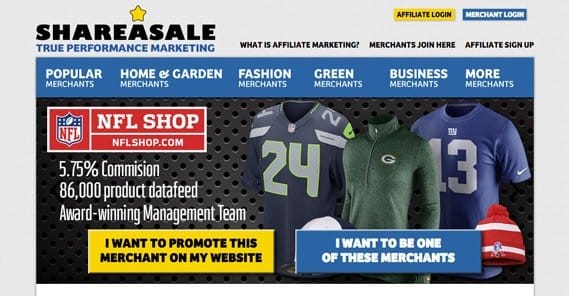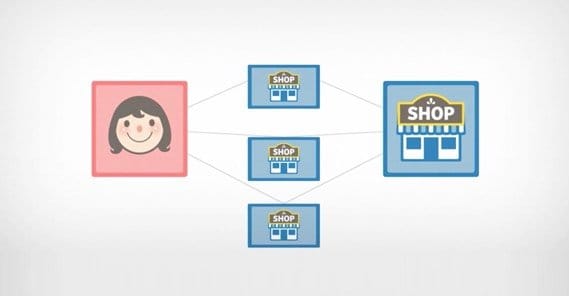6 Ways to Earn Revenue with ShareASale’s Affiliate Program

There are many ways to make money from a website or blog, but they can all be roughly categorized in one of three groups. One is text or display advertising; banner ads, AdSense, and the like. One is selling products, like software you develop or a book you wrote. The third is affiliate marketing, a cross between the two. You promote products to sell, but you don’t have to worry about anything beyond promotion and referrals.
Among the many affiliate networks out there, ShareASale is one of the best, particularly for novice bloggers.
ShareASale is an affiliate network. What this means is they are a central hub, a sort of marketplace, where vendors – businesses who want to sell products – put their affiliate offers. Publishers – that’s you, as a blogger – can pick up an offer and refer traffic along the link they are given. When you refer a user who buys a product, you get paid an amount specified by the vendor.
There are both pros and cons to using an affiliate network. For one thing, many businesses have affiliate programs directly through their own system. Going through ShareASale means you get less money than the direct method, because SAS is taking a cut. On the other hand, SAS offers support and tools to help you make the most of your advertising. They also help by attracting vendors for affiliate programs that you might not otherwise see.
See, some vendors don’t want to manage bloggers on an individual basis. It’s a lot of work, tracking referrals from hundreds of publishers, figuring out who converted, and accurately paying people. Businesses want to outsource all of that effort, and affiliate networks like ShareASale are perfectly willing to do it for a cut of the cash.
Affiliate networks also have the advantage of attracting businesses who don’t want to run an affiliate network at all. They can say “hey, look, we have 100,000 blogs ready and willing to publish your ads; that’s a lot of traffic, referrals, and potential sales, all for a low cost.” Businesses find that attractive and create offers you can’t find through any other source, not even the business directly.
You might think this leads to competition, and in a sense it does. A visible offer on an affiliate network means anyone is able to pick it up and make a site to promote it, which means that niche won’t be exclusive. However, it isn’t like there’s a fixed number of affiliate sales per quarter available. As long as you can refer people who buy the product, you can earn. No on else is stealing your profits, they’re just also using the niche. It’s up to you to find a unique spin on it.
How The Affiliate Program Works
On ShareASale, there are three types of affiliate offers, but to say so is a little misleading. One of the three categories is basically empty and void, and it’s not really affiliate marketing anyways. That’s the pay per click option, which is more like traditional display advertising.
The other two types are pay per sale and pay per lead. Pay per sale are the most traditional – and most common – of the two. You promote a product and do your best to get people to buy it. When they do buy it, you earn a commission. If they click through and look around but don’t buy, you earn nothing. If they poke around, decide they like the product, then go somewhere else – like Amazon – to buy it, you earn nothing. Unless you’re using Amazon’s affiliate program, but that’s distinct from ShareASale’s program, so we’re not considering that right now.
Pay per lead is at once easier and harder. It’s easier, because you just need to get people to express interest, not to buy. As long as they fill out a form to allow themselves to be contacted by a salesman, you earn money. It doesn’t matter if they buy or not, though some pay per lead offers will pay a bonus on a successful sale. It’s harder, though, because the products on offer are generally much more difficult sells. Where a normal pay per sale item might be a facial cream or a book or a computer part, a pay per lead product might be real estate, or a yacht, or some other big ticket item.
Using ShareASale as a publisher is much like using any affiliate program. You need a site that is capable of referring traffic, and you need to find offers relevant to your topic. You’re not going to be able to refer many people for a facial cream when you’re a blog about trains. Train models, puzzles, or artwork would be a better bet.
SAS has a pretty robust search for their offers, and they tend to have thousands available at any given time. You simply need to search through them and find what works for your site and your niche. Try to strike a balance between relevance and value.
Alternatively, you can spin off microsites for various affiliate offers. Find a high value offer and create a new website, a small blog, with some content relevant to that niche. Rank it a quickly as possible and try to refer as many sales as possible. There are many ways to accomplish this, up to and including using expired domains as fodder for microsites.
Now that you know in general how to make money from ShareASale’s affiliate offers, let’s take a look at some more specific techniques you can use, either by making a fresh site or by creating specific types of content in various locations around the web.
1. Create Deep Linking Reviews
Some of the highest converting affiliate links come from deep links. A deep link is a link buried within your site, somewhere organically in your blog. They’re more effective than links on a site focused around affiliate sales, or affiliate links in ads, because they’re taken more as legitimate opinion and recommendation than they are advertising.
This helps if you have a more personal or general interest site. If you’re recommending a product because you’ve actually used it, you like it, and you want others to like it as well, the links you include can be high converting deep links.
The idea is that you’re striving to build trust in your opinions and experiences above all else. You’re not there to advertise; you’re just including the affiliate link so that you can link to the product in a way that can benefit you. This can be helped along if you’re recommending other products that don’t have affiliate links attached as well. It lends credence to the idea that you’re in it to help others, not to make money for yourself.
When you have this kind of trust, people will treat your opinions as legitimate and good advice. They know you’re not being incentivized by money – even if you are – and that you’re recommending a good product that suits their needs.
The downside to this method is that you don’t have a lot of room to recommend competing products or a broad array of products. You’re trying to stick with products that you know and have personal experience with using, not products you think look good and can maybe write a convincing review of. There’s another style of affiliate moneymaking for that, I’ll cover it shortly.
2. Run Affiliate Display Banners
This turns your affiliate links into something a lot more like banner ads. You don’t need to clutter up your site with affiliate reviews and links in your text, which often require an ungainly disclosure notice on every post. Rather, you can just run display ads, which people expect to be advertising. You can even draw attention to them directly with messages like “click here to support this blog!”
This tends to work best with highly compelling or commonly sold products. Specialty products, particularly those high end pay per lead items, probably aren’t going to get you much out of display ads. Instead, you’re going to want to market things everyone on your blog is probably going to want. If you’re a blog about cameras and photography, a banner ad offer for a camera case or a replacement lens cap or some other accessory is probably going to work well. An ad for a high priced camera, probably not.
The problem with the display ad method is that, well, it becomes display ads, only less effective. Display ads already have issues with visibility and with viability. People don’t click ads. Heck, many people don’t even see them, due to ad blockers installed on their computer. While a textual affiliate link can slip through, a display ad certainly won’t.
You also have to rely on the user actually making a purchase, rather than just clicking the link. It’s difficult to tell users to buy an item to support you as opposed to just clicking a link, particularly when you’re not producing the item yourself. At that point, you might be better off with a donation button.
3. Make Expired Domain Microsites
This method is one you can use even if you don’t have a site already. The idea is simple; you find a high value offer in a niche you’re pretty sure you can exploit. You make a site with some content promoting the product in the offer, and you upload that site. You boost the SEO on it however you can – some people even use black hat link building here – and you let it go as long as it lasts.
Where does the expired domain come in? Expired domains tend to have some residual SEO to them for a little while after they expire. What you do is look for domain names with some residual links and traffic, and you buy them. You throw your microsite up on that domain, and those links and traffic immediately gets to work boosting your search ranking. The previous site might have even had some relevant content you can scrape or spin to use. Be wary doing so, though; sometimes that content still exists, and sometimes the content creator will send DMCA takedowns for it. Remember, just because the original host is gone, doesn’t mean the content is no longer copyrighted.
Microsites can be highly effective, but tend to have a pretty steep drop-off. They can rank highly very quickly, but they only get an initial burst of traffic and value. After a few months, or maybe as long as a year, they will drop in the rankings, lose their traffic and value, and stop earning you money. Eventually, paying for the upkeep of the site is more costly than the money the site brings in, and you restart the cycle with a different domain. You can stave off this problem by expanding and supporting the site more like a regular site, but then you have to factor in the costs of expanding, updating, and supporting the site versus the money you make from doing so.
Generally, if you’re going the microsite route, you’re going to have a dozen or so sites running at any one time, in various stages of their life cycle. You’re always on the lookout for the match up between expiring domain and affiliate offer availability. The volume helps keep your income steady even as some sites rise and others fall, and gives you seed money to start new sites before they reach profitability.
4. Sell Recurring Commission Subscriptions
This one involves putting more effort into a site that sells a special type of offer. That offer is the tiered or recurring offer.
Essentially, rather than selling a discrete product, you’re selling a service or a subscription. Magazine subscriptions are the most common, but a fitness course or instrument lessons also fit the bill. The idea is that these are services or products that cost money to the customer every month.
Some affiliate networks have vendors that provide these recurring offers, so you need to specifically seek them out. Say, for example, you find an offer of virtual guitar lessons for $10 a month. Of that $10 monthly fee, you earn $3. That’s not a lot, though it’s kind of middle of the road for many affiliate networks.
The difference is that with a traditional affiliate offer, you sell a digital guitar lesson package for $10, earn $3, and that’s the end of it. With a subscription service, you sell it, and maybe the person who buys it signs up for six months. You get $3 a month for 6 months, which totals $18. $36 a year isn’t very good, but when you have 1,000 people signed up for 12 months each at $3 a month, suddenly you’re making quite a lot of money. Compounding recurring revenue can be a beautiful thing.
The trick is to find offers that either have long-term value or the “forgot it” factor. The former are the most useful, because satisfied people keep using the service. If Netflix offered a recurring commission, you can bet people would be all over it. The “forgot it” factor is how gyms make their money; they sign someone up in January for new years resolutions, and that person forgets to cancel for 10 months, during which time the gym – and the referrer – have made quite a bit of money off of the inactivity of the user.
5. Focus on High Value Pay Per Lead Offers
This one is more about making a single high pressure sales site. Say you find one pay per lead offer on something crazy, like a private jet. You, uh, probably won’t actually find this. Still, you don’t need to sell the jet… or do you? Actually, you need to do some work.
What you need to do is spend time identifying the kinds of people who would be interested in buying that jet, and figuring out the kinds of websites they’re going to be visiting. You’re going to be looking for ways you can contact these people and bring them to your site, where they can read all about the benefits of a private jet. You need to sell them on the idea of at least contacting the seller of the jet, to see if it’s really the right choice for them. Very few people are going to impulse buy a jet, of course, but that’s not your problem.
The trick is to realize that you don’t actually need to sell the jet, you just need to make the jet sound attractive. Once the rich jet-less celebrity fills out the form to contact the jet sales force, you earn the payment. Where they go from there is completely irrelevant to your income, and you can safely forget it all.
6. Create an Industry Comparison Site
This is one of the more common methods for a long-lived affiliate site. Be aware that it’s not something like the microsites, where you can start it up, let it go, and repeat later for another offer.
Essentially what you’re trying to do is pick a niche and dominate it with reviews of everything in that niche. For example, say you pick PC headsets as your target niche. What you do is then go through and find every affiliate offer you can for PC headsets. Find them through ShareASale, find them on Amazon, find them in OfferVault, anywhere they exist.
Now you write detailed reviews of every headset you can find. Write pros, write cons, write from a position of authority as an audiophile with a dedicated testing setup. It helps if you actually have a setup, of course; personal experience is more believable than generic writing.
For each review, include an affiliate link to where the user can buy the headset. Keep these links updated, so you always have a way to make money if someone likes your review and clicks through.
The problem here is that you need a lot of content to dominate the niche, and most broad niches – like headsets – are already filled. You have to do something exceptional to be noticed, and that can be pretty difficult when you’re basing yourself around affiliate offers. The tradeoff, of course, is that this kind of affiliate site can last literally forever, as long as the product exists and people use it.
 ContentPowered.com
ContentPowered.com










IncomeHustler
says:thanks Im finding a ton good articles on your site to read.